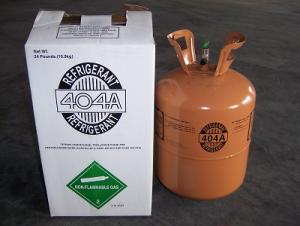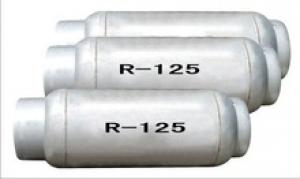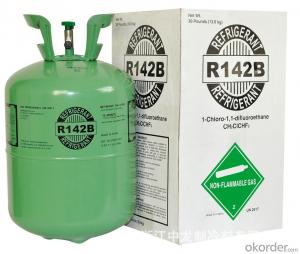Blend Refrigerant R404a
- Loading Port:
- Shanghai
- Payment Terms:
- TT OR LC
- Min Order Qty:
- -
- Supply Capability:
- 1000MT m.t./month
OKorder Service Pledge
Quality Product, Order Online Tracking, Timely Delivery
OKorder Financial Service
Credit Rating, Credit Services, Credit Purchasing
You Might Also Like
Specifications
R404a refrigerant gas
1,R404a of all specification
2,OEM is accepted
3,SGS/ROSH/PONY
4,ISO9001, ISO14001,ISO16949
Product details----Mixed Refrigerant R404A
Physical Property:
| Molecular Weight | 97.6 |
| Boiling Point,°c | -46.5 |
| Critical Temperature,°c | 72.1 |
| Critical Pressure, Mpa | 3.74 |
| Specific Heat of Liquid, 30°c ,[KJ/(KG.°c )] | 0.38 |
| ODP | 0 |
| GWP | 3800 |
Quality Index:
| Purity,% | ≥99.9 |
| Moisture, PPm | ≤10 |
| Acidity, PPm | ≤1 |
| Vapor Residue, PPm | ≤100 |
| Appearance | Colorless, No turbid |
| Odor | No Strange Stench |
Packing:
Disposable cylinder 24lb/10.9kg
Recyclable cylinder 400L, 800L, 926L;
ISO-Tank
Application:
Retrofited refrigerant for R502.
- Q: What does organic and inorganic mean?
- [Inorganic] inorganic is inorganic compounds referred to, usually refers to non-carbon compounds. A small number of carbon-containing compounds, such as carbon monoxide, carbon dioxide, carbonates, cyanides, etc. are also inorganic. Inorganic materials can be divided into oxides, acids, alkalis, salts and so on. Organic compounds Definitions Organic compounds usually refer to carbon-containing compounds, or hydrocarbons, and their derivatives, are collectively referred to as organic compounds.
- Q: Sugar, fat, and so on a variety of organic matter is full of different units of the heat of the small box. (Save the heat the most efficient, the least loss of heat the most practical and most economical box).
- Inorganic matter with carbon after, as if with their own ideas, began to build their own. So slowly evolved into a complex organic matter
- Q: China's largest asphalt production base where
- Coal tar pitch is a byproduct of coking, that is, the black material that remains in the distillation kettle after distillation of the tar. It is only fine with the physical properties of refined tar, there is no obvious boundaries, the general division method is to specify the softening point at 26.7 ℃ (cubic method) for the following tar, 26.7 ℃ above the asphalt. Coal tar pitch mainly contains volatile anthracene, phenanthrene, pyrene and so on. These substances are toxic, because the content of these components are different, the nature of coal tar pitch is also different. The change of temperature has great influence on coal tar pitch, which is easy to brittle in winter and easy to soften in summer. Heating with a special smell; heated to 260 ℃ in 5 hours later, it contains anthracene, phenanthrene, pyrene and other ingredients will be volatile.
- Q: Will AsH3 (arsenic trioxide) is organic or inorganic
- Organic matter refers to carbon-containing compounds, or hydrocarbons and their derivatives are collectively referred to as organic compounds.
- Q: Are there two derivatives of equivalent hydrogen?
- You give the scope is too broad, at least to set in what kind of functional group range ah.
- Q: Cracked
- It is almost impossible for this problem to look at your reaction conditions. Generally speaking, the alkane reaction is mainly difficult to decompose directly into ions
- Q: What is the meaning of organic ah, organic food on the human body what practical benefits
- Food point of view of organic: from planting to harvest, and then to storage, transport so that consumers in the hands, without chemical fertilizers, chemical processing, genetic technology and other food raw materials. In general, organic represents high quality and natural. But the Chinese market is not very close, so the choice of time to pay attention.
- Q: What is the difference between hot and cold asphalt?
- Cold mixed high-strength asphalt concrete, by adding asphalt in the thermosetting resin, coupled with the right amount of solvent to form a semi-flow asphalt binder, and the appropriate mix of aggregate from the asphalt concrete mixture. This asphalt concrete is a very high strength of 60 ℃, 30mm Marshall stability of 30000N, flow 20-30 (1 / 10mm), the stability of ordinary asphalt concrete is about 3 times, with good rutting resistance. Hot asphalt is composed of different molecular weight hydrocarbons and non-metallic derivatives of dark brown complex mixture, is a high viscosity organic liquid, was liquid, the surface was black, soluble in carbon disulfide. Asphalt is a waterproof moisture and corrosion of organic cementitious materials. Asphalt can be divided into coal tar pitch, petroleum asphalt and natural asphalt three: Among them, coal tar pitch is a by-product of coking. Petroleum asphalt is the residue after distillation of crude oil. Natural asphalt is stored in the ground, and some of the formation of ore or in the crustal surface accumulation. Asphalt is mainly used for coatings, plastics, rubber and other industries and pavement and so on.
- Q: What cells are composed of compounds
- Protein and water
- Q: Is the number of hydrogen atoms in the hydrocarbon or hydrocarbon derivative molecule be even
- The number of hydrogen atoms in the hydrocarbon must be even.
Send your message to us
Blend Refrigerant R404a
- Loading Port:
- Shanghai
- Payment Terms:
- TT OR LC
- Min Order Qty:
- -
- Supply Capability:
- 1000MT m.t./month
OKorder Service Pledge
Quality Product, Order Online Tracking, Timely Delivery
OKorder Financial Service
Credit Rating, Credit Services, Credit Purchasing
Similar products
Hot products
Hot Searches






















